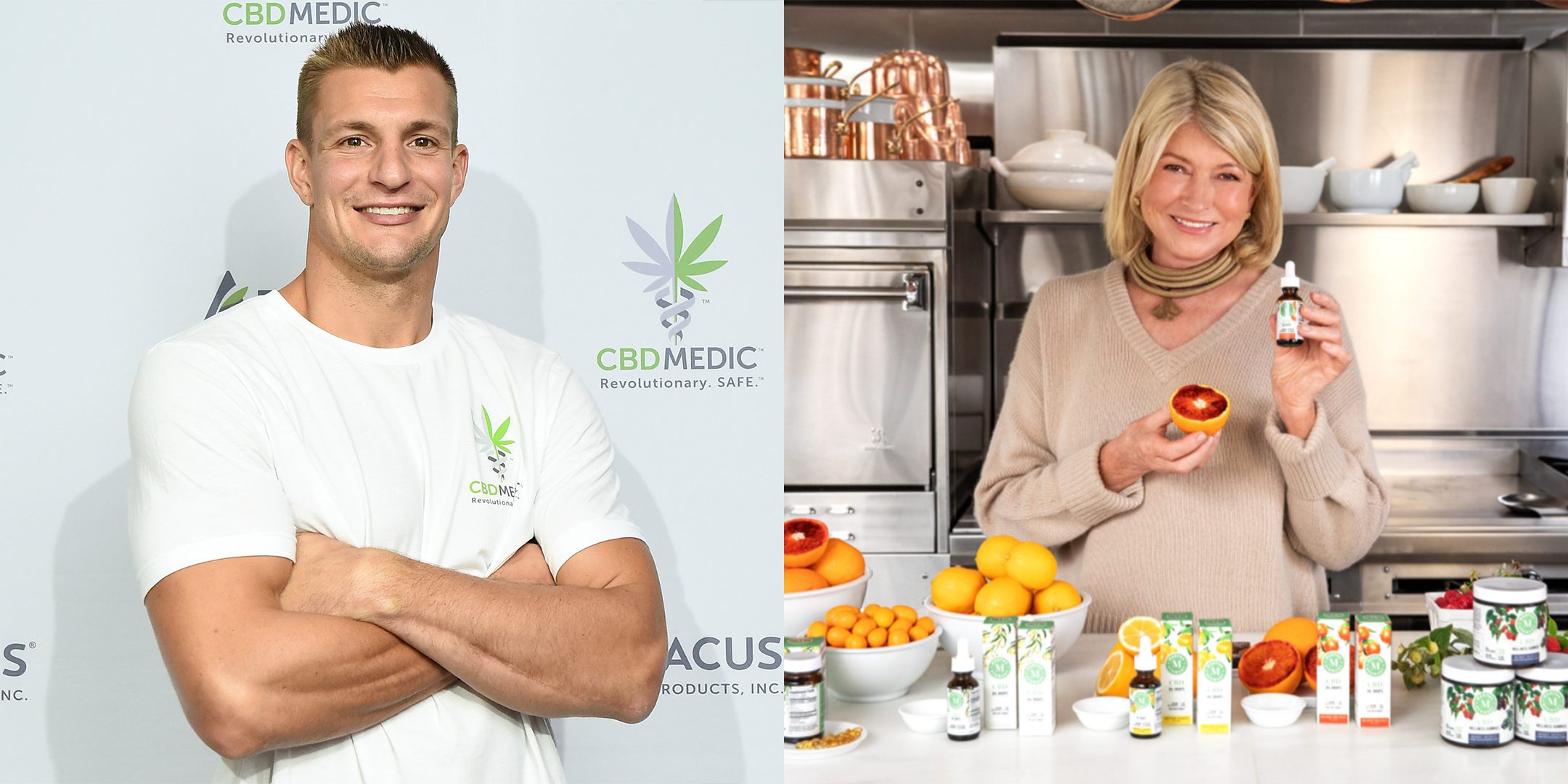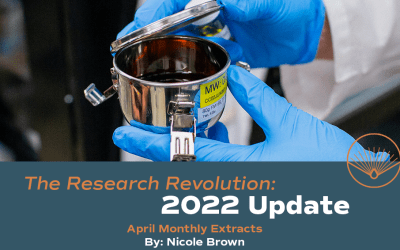Author: Dave Neundorfer
September 30, 2020 – 5 min read
Martha, Gronk, and Playboy–cultural icons brought together by their full-throated endorsements of CBD as part of a continuing trend of big brands and businesses entering the space. This trifecta of influence is a bellwether for a category that, in the last two years, has gone from cottage industry, to edgy fad, to what is fast becoming a mainstay of the mainstream.
This groundswell of big names entering the space–Martha Stewart, Gronk, and Playboy, not to mention Perrigo, Prinova, Ocean Spray, John Paul De Joria, Kadenwood, and Unilever–has proven wrong the conventional wisdom that regulatory clarity was a prerequisite for CPG’s, big box retailers, and conventional influencers and icons.
Considering the accelerating supply chain maturation, continued enforcement discretion from the FDA, and the size of the prize of the cannabinoid category, it’s no surprise that the following lineup is already in market.
- April 2019: Vitamin Shoppe becomes one of the first major retailers to carry ingestible CBD products (Last month, they further announced the launch of its new CBD HQ in-store and online concept, an industry-leading destination for CBD hemp extract wellness solutions)
- August 2019: Garden of Life launches their debut CBD collection, including CBD drops, soft gels, and sprays.
- November 2019: Lagunitas launches Hi-Fi Hops, a CBD-infused seltzer
- January 2020: Colgate-Palmolive announces the acquisition Hello Products LLC (“Hello”), one of the fastest-growing, premium oral care brands in the United States, which features a CBD toothpaste and CBD mouthwash
- April 2020: Molson Coors forms a joint venture with HEXO to explore hemp-derived CBD beverage, part of Molson Coors’ strategy to grow beyond the beer aisle
- June 2020: Ocean Spray launches CarryOn, a CBD-infused sparkling beverage, through Ocean Spray’s Lighthouse Incubator
- September 2020: Iconic adult entertainment brand Playboy announces a line of signature intimacy products, infused with CBD.
- September 2020: Martha Stewart launches her debut CBD collection
- September 2020: Neptune Wellness partners with consumer packaged goods giant Unilever as an import and stocking distributor and logistics partner in the U.S. and Canada
- September 2020: Nestle launches broad-spectrum CBD softgel formulations with a special droplet delivery system known as VESIsorb
It has become clear that the mass market is not waiting for the regulatory big bang and neither are leading brands. While the FDA is focused on COVID and congress waits out its lame duck session, why is this happening now?
First, the industry’s supply chain has gone through a significant maturation process since the passing of the 2018 Farm Bill.
At that time, the default cannabinoid ingredient was CBD isolate, it cost ~$6,000 / kg, there were few, if any, processors who could trace their isolate back to the farm where the hemp was grown (in fact, much of the isolate at that time was imported from China), no processor was GMP-compliant, let alone GMP-certified, and certificates of analysis (COA’s) were pencil-whipped, if prepared and shared at all.
The supply chain has improved dramatically, driven by a more educated consumer base demanding consistency, safety, and efficacy. This consumer-driven flight to quality has forced brands to demand more of their supply chains, including cGMP-compliance (if not certifications), exhaustive stability and potency testing, and transparency and traceability throughout the production and testing processes.
No longer can a brand survive because it has the letters “CBD” on its label–products need to work, and the efficacy focused-consumers have forced formulators to choose cannabinoid ingredients based on their product and consumer experience goals. As a result, leading processors give brands significantly more cannabinoid ingredient options, including THC-free distillates, water soluble full- and broad-spectrum cannabinoids, and minor cannabinoids in pure, isolated form or in water soluble powder or concentrated liquid, to name a few.
Consumer education, supply chain maturation, and dramatic ingredient innovation, all in one year? As we say, this is a “dog year” market, so one calendar year equates to seven years of cannabinoid market evolution. Case in point, since December, 2019, the three largest US-based processors have all gone through restructuring, the price of CBD isolate has dropped by nearly 10X (these phenomena are highly correlated), and the number of brands in the market is contracting rapidly.
The second reason big name brands are embracing cannabinoids is that we now have nearly two years observing the FDA’s regulation of the industry.
Yes, the FDA is regulating the cannabinoid industry, it is exercising enforcement discretion to allow continued sales as long as companies are not making unsubstantiated health claims. Unsubstantiated health claims–examples include CBD curing Alzheimer’s, cancer, COVID–have been the only source of FDA warning letters that came with stern words as opposed to fines or other penalties. While it may be years until non-drug pathways are clarified for cannabinoids, there is negligible risk for brands with reputable supply chain partners launching responsibly marketed cannabinoid-infused topicals, supplements, and food and beverage additives.
The size of the carrot is the third and primary reason for household brands entering the fold–few, if any product categories have had the global, cross-category, broadscale demographic appeal.
Case in point, Gronk’s followers are predominantly male millennials whereas Martha Stewart’s followers are primarily female boomers. These disparate demographics are a bridge too far for any other product category, but not for cannabinoids. Millennials use cannabinoids to address anxiety, boomers for aches and pains, and, with benefits across sleep support, skin care, and general wellbeing, cannabinoids have “touch-em-all” potential for a consumer-based that is informed and primed. In the US, awareness of CBD is over 80%, it took coconut water twenty years to reach that level of market awareness, a feat the CBD category has reached in under two.
Whereas Martha is leading the charge in the US, the former Miss World, Priyanka Yoshikawa, is launching Mukoomi in Japan. This fever pitch is not a domestic phenomenon, countries the world over are having or preparing for their own ‘2018 Farm Bill’ moments, and Asia is expected to be the largest cannabinoid market in the world in the coming years
So, here are the takeaways from this market backdrop and the moves made by Gronk, Martha and Playboy.
- For CBD brands, make sure you’ve upgraded your supply chain or be left behind.
- For Non-CBD brands, start R&D today if you haven’t already. Again, the CBD market moves in dog years.
- For Product Developers, take advantage of the new ingredient technologies on the market. The entourage effect is a primary driver of efficacy and there are many cannabinoid blends that have yet to be discovered that will drive the customer experience your consumers desire.
- For consumers, share feedback and critique openly and keep demanding more of your brands and of your cannabinoid products, as this market, more than any other, has and will continue to be driven by the end consumer.
Author: Dave Neundorfer
September 30, 2020 – 5 min read
Martha, Gronk, and Playboy–cultural icons brought together by their full-throated endorsements of CBD as part of a continuing trend of big brands and businesses entering the space. This trifecta of influence is a bellwether for a category that, in the last two years, has gone from cottage industry, to edgy fad, to what is fast becoming a mainstay of the mainstream.
This groundswell of big names entering the space–Martha Stewart, Gronk, and Playboy, not to mention Perrigo, Prinova, Ocean Spray, John Paul De Joria, Kadenwood, and Unilever–has proven wrong the conventional wisdom that regulatory clarity was a prerequisite for CPG’s, big box retailers, and conventional influencers and icons.
Considering the accelerating supply chain maturation, continued enforcement discretion from the FDA, and the size of the prize of the cannabinoid category, it’s no surprise that the following lineup is already in market.
- April 2019: Vitamin Shoppe becomes one of the first major retailers to carry ingestible CBD products (Last month, they further announced the launch of its new CBD HQ in-store and online concept, an industry-leading destination for CBD hemp extract wellness solutions)
- August 2019: Garden of Life launches their debut CBD collection, including CBD drops, soft gels, and sprays.
- November 2019: Lagunitas launches Hi-Fi Hops, a CBD-infused seltzer
- January 2020: Colgate-Palmolive announces the acquisition Hello Products LLC (“Hello”), one of the fastest-growing, premium oral care brands in the United States, which features a CBD toothpaste and CBD mouthwash
- April 2020: Molson Coors forms a joint venture with HEXO to explore hemp-derived CBD beverage, part of Molson Coors’ strategy to grow beyond the beer aisle
- June 2020: Ocean Spray launches CarryOn, a CBD-infused sparkling beverage, through Ocean Spray’s Lighthouse Incubator
- September 2020: Iconic adult entertainment brand Playboy announces a line of signature intimacy products, infused with CBD.
- September 2020: Martha Stewart launches her debut CBD collection
- September 2020: Neptune Wellness partners with consumer packaged goods giant Unilever as an import and stocking distributor and logistics partner in the U.S. and Canada
- September 2020: Nestle launches broad-spectrum CBD softgel formulations with a special droplet delivery system known as VESIsorb
It has become clear that the mass market is not waiting for the regulatory big bang and neither are leading brands. While the FDA is focused on COVID and congress waits out its lame duck session, why is this happening now?
First, the industry’s supply chain has gone through a significant maturation process since the passing of the 2018 Farm Bill.
At that time, the default cannabinoid ingredient was CBD isolate, it cost ~$6,000 / kg, there were few, if any, processors who could trace their isolate back to the farm where the hemp was grown (in fact, much of the isolate at that time was imported from China), no processor was GMP-compliant, let alone GMP-certified, and certificates of analysis (COA’s) were pencil-whipped, if prepared and shared at all.
The supply chain has improved dramatically, driven by a more educated consumer base demanding consistency, safety, and efficacy. This consumer-driven flight to quality has forced brands to demand more of their supply chains, including cGMP-compliance (if not certifications), exhaustive stability and potency testing, and transparency and traceability throughout the production and testing processes.
No longer can a brand survive because it has the letters “CBD” on its label–products need to work, and the efficacy focused-consumers have forced formulators to choose cannabinoid ingredients based on their product and consumer experience goals. As a result, leading processors give brands significantly more cannabinoid ingredient options, including THC-free distillates, water soluble full- and broad-spectrum cannabinoids, and minor cannabinoids in pure, isolated form or in water soluble powder or concentrated liquid, to name a few.
Consumer education, supply chain maturation, and dramatic ingredient innovation, all in one year? As we say, this is a “dog year” market, so one calendar year equates to seven years of cannabinoid market evolution. Case in point, since December, 2019, the three largest US-based processors have all gone through restructuring, the price of CBD isolate has dropped by nearly 10X (these phenomena are highly correlated), and the number of brands in the market is contracting rapidly.
The second reason big name brands are embracing cannabinoids is that we now have nearly two years observing the FDA’s regulation of the industry.
Yes, the FDA is regulating the cannabinoid industry, it is exercising enforcement discretion to allow continued sales as long as companies are not making unsubstantiated health claims. Unsubstantiated health claims–examples include CBD curing Alzheimer’s, cancer, COVID–have been the only source of FDA warning letters that came with stern words as opposed to fines or other penalties. While it may be years until non-drug pathways are clarified for cannabinoids, there is negligible risk for brands with reputable supply chain partners launching responsibly marketed cannabinoid-infused topicals, supplements, and food and beverage additives.
The size of the carrot is the third and primary reason for household brands entering the fold–few, if any product categories have had the global, cross-category, broadscale demographic appeal.
Case in point, Gronk’s followers are predominantly male millennials whereas Martha Stewart’s followers are primarily female boomers. These disparate demographics are a bridge too far for any other product category, but not for cannabinoids. Millennials use cannabinoids to address anxiety, boomers for aches and pains, and, with benefits across sleep support, skin care, and general wellbeing, cannabinoids have “touch-em-all” potential for a consumer-based that is informed and primed. In the US, awareness of CBD is over 80%, it took coconut water twenty years to reach that level of market awareness, a feat the CBD category has reached in under two.
Whereas Martha is leading the charge in the US, the former Miss World, Priyanka Yoshikawa, is launching Mukoomi in Japan. This fever pitch is not a domestic phenomenon, countries the world over are having or preparing for their own ‘2018 Farm Bill’ moments, and Asia is expected to be the largest cannabinoid market in the world in the coming years
So, here are the takeaways from this market backdrop and the moves made by Gronk, Martha and Playboy.
- For CBD brands, make sure you’ve upgraded your supply chain or be left behind.
- For Non-CBD brands, start R&D today if you haven’t already. Again, the CBD market moves in dog years.
- For Product Developers, take advantage of the new ingredient technologies on the market. The entourage effect is a primary driver of efficacy and there are many cannabinoid blends that have yet to be discovered that will drive the customer experience your consumers desire.
- For consumers, share feedback and critique openly and keep demanding more of your brands and of your cannabinoid products, as this market, more than any other, has and will continue to be driven by the end consumer.




